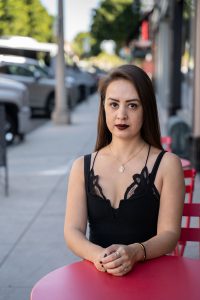Written by Viviane Anthony

Autumn Krause started her writing journey by working in a high-end bridal salon in Beverly Hills. Krause grew up in a blue-collar family in Harbor City, in a racially and economically diverse neighborhood, so being surrounded by that kind of wealth was new to her. That’s when the story of a working-class girl competing at an iconic fashion house came to life.
Last August Krause released her debut young adult novel, “A Dress for the Wicked,” a story about an 18th century country girl who got the opportunity of a lifetime when she started competing in one of the biggest fashion houses of her country.
Just like Krause, Emmy, the lead character in the novel, got “thrust into this really glittering, beautiful, glamourous world.” But wealth comes with a price, and the book exposes a world of sabotage, elitism and drama. Her novel mirrors the real-world fashion industry that she chose to expose in her book.
For Krause, young adult novel writing is a way to be imaginative. It’s a way to create fantasy and made-up worlds that you sometimes can’t have with other genres.
“You can be a little more extreme than you can in other genres,” she says.
Young adult fiction features adolescents beginning to transform into adults, working through personal problems, and learning to take responsibility for their actions.
“There’s something about this coming-of-age story that’s so universal,” Krause says.
“A Dress for the Wicked” takes place in the fictional city of Avon-upon-Kynt, where fashion is omnipresent. When Madam Jolene, the matron of the only fashion house of the city, is forced to include “country girls” in her competition, Emmy sees her chance to get out of her little country town. She competes against other girls in order to win money, clothes and a contract as a fashion designer. Emmy enters the competition without really knowing that, despite her talent, Madam Jolene would never let her win because of her “poor” background.

“I set it in the Victorian period because I really liked the structured etiquette, the sensibility for beauty at the time,” Krause says. The Victorian society was divided into upper-class, middle-class and the working-class.
These restrictive class systems make a good setting for her book as she highlights the separation between the working-class girl Emmy and the upper-class fashion house of Madam Jolene.
Even though Krause likes the style of the Victorian era, she felt that it was important to modernize it.
“The way fashion works in the novel is that I took the way a modern fashion house would work and I put it in the Victorian time,” Krause explains. For instance a historically accurate fashion house wouldn’t have a creative director, which is a modern position.
In the novel Emmy’s life is basically a mirror of Krause’s but only “way more exaggerated,” as she put it. However, in terms of personality and style, Krause says she has more in common with another character – one of Emmy’s roommates and her competitor as a designer.
“As far as fashion, sensibility and style goes I’m way more like Sophie.”
Indeed, Krause and Sophie have a style that stands out: a dark, dramatic, goth kind of look that includes lace and tulle.On a recent Wednesday in September, Krause arrived at Pilgrims Cafe in downtown Fullerton in a black dress, black purse and shoes and dark sunglasses. She had her signature burgundy lipstick and dark nail polish.
Even though fashion is omnipresent in her novel, Krause hopes that her readers can learn more about the creative process and why creating is important to humans.
“When you create, it is a natural expression of your soul, and the book overall is an homage to that and an exploration on that process,” she says.
According to Krause, every stage of writing has its difficulty, whether it’s the drafting, revising or the promotion once the book is out. She sometimes asks herself if it makes any sense. Despite the difficulties Krause’s book got published not long after she finished graduate school and sold out very quickly.
“The book was basically my thesis for my MFA program,” she explains. “Then, I revised with an agent for quite a bit of time, about two years, and then it sold!” she said enthusiastically.

One thing that’s difficult for her might be that her sensitive personality makes it hard to handle bad or rude reviews. But the upside of novel writing is that she gets to see her readers face to face and see the people who really enjoyed her work.
“One very sweet reader told me that she was so stressed during the story that she snapped at her husband, which I found very funny because I’ve totally done that too when immersed in a good book,” she says.
While the contrast of her life growing up in Harbor City and her working in Beverly Hills was the inspiration for this book, Krause now lives in Fullerton, where she’s been for the past five years. Other than being busy with her book release, Krause enjoys the downtown Fullerton life.
“Where I grew up there wasn’t a designated downtown area,” she says. “I never had a charming place with such cool privately-owned coffee shops and such beautiful stores and lovely people.”
Part of her novel was written in one of the many offices a writer can have: a café. In this case, it was the Night Owl in downtown Fullerton.
“I just like the moody vibe there. It feels gritty but in a very cool way,” she explains.
These days, Krause spends her time promoting her book and working on two other novels which are both very different from “A Dress for the Wicked.” But she still keeps her love for fashion in her writing, as she has included unique clothing that are part of the narratives.

